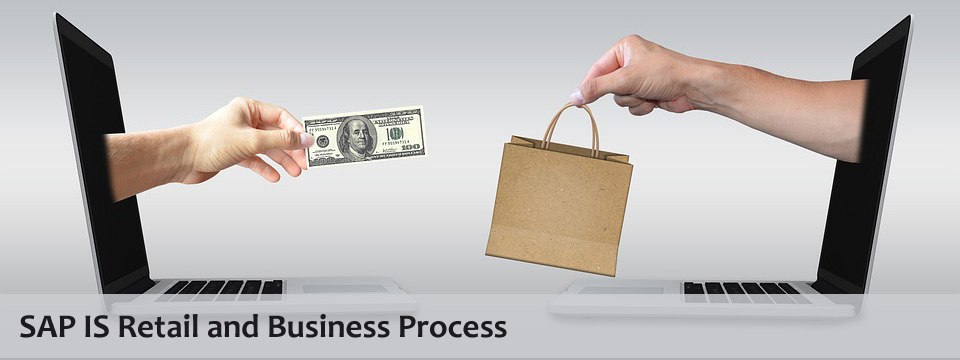
Please note that LearnSAP LLC is an independent training provider and is not affiliated with, endorsed by, or in any way officially connected with SAP.
SAP IS Retail (ISR) Solution is an industry specific software. It is fully integrated comprehensive ERP (Enterprise Resource Planning) solution for business and retail industry. It is very well suited for both, small and large scale enterprises. The solution can be mapped for all the proprietary business scenarios, business processes, and business functions.

The IS retail solution helps bring marketing, merchandise, supply chain and IT to provide competitive edge to a business.
The retail solution provides a complete integration for all the divisions / business processes of a retail company, which is typically food and beverages, hard goods and fashion retailers. The solution is highly customizable to suit varied requirements.
SAP's flagship software ECC 6.0 (Enterprise Central Component version 6.0) is already established as the top-choice for manufacturing, trading, or service providers. The ECC system has three core Modules which corresponds to the business process of an organization:
The Logistics in turn has two major components, namely Materials Management (MM), Sales and Distribution (SD). Besides this, Production Planning (PP), Plant Maintenance (PM), Quality Management (QM) and Warehouse Management (WM) can be considered as extensions of Materials Management.
When you look at the SAP IS Retail, it includes all these ECC components and then some. The main heart of the system is the functionality which is specially developed to cater to retailing companies and these are called IS Retail Components. To name a few,
IS Retail components can be broadly divided into following categories.
This is basically the enterprise structure and we use almost all the Organization Units that are available in the SAP system, like
SAP IS Retail has got a very elaborate Master Data which forms the basis of transaction processing. The typical most important Master Data I will describe as:
Article master contains information on all the products (materials, items) that an organization procures, manufactures, stores and sells.
Articles are procured for a Distribution Center (Site) and from there they are delivered to individual stores and/or external customers.
Merchandise category helps classify and structure all the items / materials / articles in an organization which have similar properties. An article is assigned to a merchandise category (it is similar to material group in core ECC system). Merchandise categories can be grouped together to form merchandise category hierarchy.
A vendor is an Accounts Payable master in financial and from Materials Management Procurement point of view its a business partner from whom we procure goods or services. Each Distribution center is a vendor in Retail solution.
A customer is a business partner of an organization. It is both a financial master as well as sales master. In financials, it is the Accounts receivable master or can be classified as debtors. Every site is a customer in Retail solution.
Another very important part of the Master Data would be the Retail Pricing and Classification. Classification is very vital in IS Retail. We use classification to group various entities with similar characteristic, like sites for promotion, merchandize assortment planning, or even merchandize distribution.
Another very important proprietary master data would be the Assortment. The Assortment forms the heart of the SAP IS Retail system. Assortment is a logical object which has got the articles and assortment as a user (a user in this case can be a retail-site).
We can also maintain promotions that happen in the retail business as a master data. And based on the promotions we can do various subsequent planning. In seasonal products we have something called marked down planning for automatic markdown of prices depending on how the season progresses.
Here is the description of SAP IS retail business process
In retailing business, business plan merchandise requirements based on demand, market trends at regular internals for their distribution centers. This leads to placing a purchase order with the vendor.
The vendor delivers the merchandise ordered and it is recorded in the system as goods receipts against a purchase order. The outcome of this process - increase in the inventory in the distribution centers and at the same time increase in the value of the inventory along with a liability towards the vendor supplying merchandise.
The invoices when received from vendor against the delivery of merchandise are verified, any volume discounts and rebates applied and payment released.
The replenishment process of merchandise can be automated using Requirement Planning where by a purchase requisition created are automatically converted into Purchase order proposal and confirmed or released as Purchase orders.
In retail business, usually relationship between vendors is established over a period of time. But it may be necessary at time for procurement of high value articles or bulk quantity to request for quotations and evaluate the quotes. SAP also has the process for request for quotations that can be applied during the procurement process.
In SAP IS Retail, shipping notifications are used by vendors to inform the delivery of articles and will have details regarding the delivery date, time and quantity. An inbound delivery is entered for the shipping notification either manually or via EDI.
IS is a reporting system which helps to collect, analyze and aggregate data that is relevant to retailing areas like purchasing, sales, inventory, point of sales. SAP recommends retailers using SAP to use SAP business intelligence system to analyze data.
Click Here to go back to Articles page.